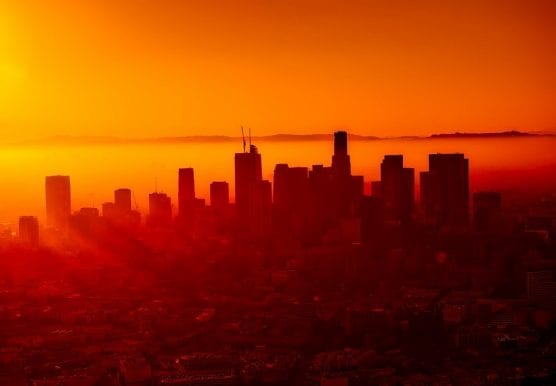By Martin Macias Jr.
More residents died from air pollution in Los Angeles County in 2017 than in any other U.S. county, according to a new study released Wednesday, but nationally, the number of deaths and illnesses caused by smog has fallen dramatically in the last decade.
The annual “Health of the Air” report – produced by the American Thoracic Society and the Marron Institute at New York University – features nearly a decade of data on fine particle dust levels, called PM2.5, in 500 U.S. counties and ground-level ozone level in 700 counties.
Ground-level ozone occurs when sunlight hits the Earth and creates a chemical reaction by mixing with nitric oxides and volatile organic compounds. The pollutant can cause a variety of health problems, especially for children, the elderly and people who have lung diseases, according to the Environmental Protection Agency.
The report, published Wednesday in the Annals of the American Thoracic Society, reported that 7,140 people died from both pollutants in 2017 – the most recent year data is available – which is down from 12,600 deaths in 2010.
The nearly 50% drop can be attributed to a national decrease of fine particles in the air, report co-author Gary Ewart said in a statement, adding that air pollution could increase again unless the government takes action to protect air quality.
“The proposed rollback of several Clean Air Act regulations and the proposed rollback of the greenhouse gas standard for automobiles will make it hard for communities to maintain their air quality, and even harder for cities with poor air quality to clean up,” Ewart said.
The study also lists the 10 areas of the country that experienced the highest levels of deaths caused by both fine particle dust and ground-level ozone pollutants in 2017.
San Bernardino and Riverside counties southeast of Los Angeles claimed the second spot on the list after Los Angeles, and Bakersfield, a Central Valley city north of LA, rounded out the top three listings, according to the report.
Researchers said that, across the country, 3,260 people died in 2017 from fine particle dust exposure, down from 8,330 in 2010.
While fine particles are beginning to clear up, ground-level ozone has “remained stubbornly high,” according to the study, and caused the deaths of 3,880 people in 2017, down from 4,270 in 2010.
Pollution data tied to wildfire events was excluded from the study, but researchers said the “increasing frequency and severity [of wildfires] may limit the improvements in health that cities and counties can achieve by reducing other air pollution sources.”
The EPA recently designated many places in the U.S. as having air quality that is worse than the National Ambient Air Quality Standard, and states that don’t meet this standard in the next three years will be required to do so by law.
“The large number of adverse health impacts attributable to ozone should motivate cities and states to start now to reduce their local emissions of precursors pollutants,” said study co-author Kevin Cromar of the Marron Institute. “Coordinated actions at the regional level, as well as strong actions at the federal level, will also be needed in order to make consistent gains in reducing ozone in many parts of the country.”
Like this:
Like Loading...
Related





 Tweet This
Tweet This Facebook
Facebook Digg This
Digg This Bookmark
Bookmark Stumble
Stumble RSS
RSS


























REAL NAMES ONLY: All posters must use their real individual or business name. This applies equally to Twitter account holders who use a nickname.
1 Comment
Start deporting illegals who contribute to our poor air quality and watch those number improve.